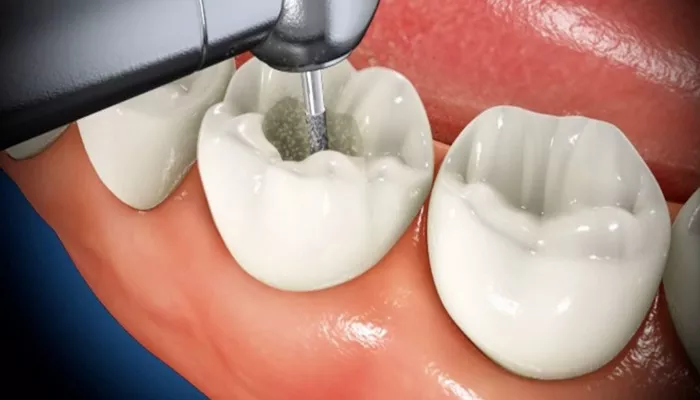A crown filling is a dental restoration technique that involves filling a damaged or decayed tooth and covering it with a dental crown. It is used when a regular filling is not enough to restore the tooth’s function or structure. A crown filling provides strength, durability, and protection, especially when a large portion of the tooth is affected.
Difference Between a Filling and a Crown Filling
A standard dental filling repairs small cavities or damage using composite or amalgam material. In contrast, a crown filling includes the placement of a crown—typically made from porcelain, ceramic, or metal—to encase the entire tooth. This method is more extensive and is often required after root canal therapy or when more than 50% of the tooth structure is compromised.
When Is a Crown Filling Necessary?
Severe Tooth Decay
If decay has destroyed much of the natural tooth, a crown filling is necessary to restore functionality and prevent further damage. Large fillings alone would be too weak to support chewing forces.
Cracked or Broken Teeth
Cracked or fractured teeth, especially molars, benefit from crown fillings. A crown acts as a cap, preventing the crack from worsening and holding the tooth together.
After a Root Canal
Teeth that have undergone root canal therapy become brittle. A crown filling ensures these teeth can withstand biting forces and stay intact.
Materials Used in Crown Fillings
Porcelain and Ceramic
These are aesthetically pleasing and ideal for front teeth. They match the natural tooth color and are stain-resistant.
Metal Crowns
Gold or base metal alloys are extremely durable. They are typically used on molars due to their strength but are less aesthetic.
Porcelain-Fused-to-Metal (PFM)
These combine aesthetics and strength. The porcelain exterior provides a natural look, while the metal substructure adds durability.
Resin-Based Crowns
Resin crowns are cheaper but less durable than other types. They may be used temporarily or for patients on a budget.
The Crown Filling Procedure
Step 1: Tooth Preparation
The dentist removes decay and shapes the remaining tooth. If there’s not enough tooth left, a filling material builds it up before placing the crown.
Step 2: Taking Impressions
Dental impressions are made to ensure the crown fits perfectly. These impressions are sent to a dental lab.
Step 3: Temporary Crown Placement
A temporary crown is placed while the permanent one is being made. This protects the tooth and helps with normal function.
Step 4: Permanent Crown Placement
Once ready, the permanent crown is cemented onto the tooth. The dentist checks the fit, bite, and aesthetics before finalizing it.
Benefits of a Crown Filling
Improved Tooth Strength
The crown reinforces the weakened tooth, reducing the risk of fractures and further decay.
Better Functionality
Crown fillings restore normal chewing and speaking ability, which may be impaired by a damaged tooth.
Enhanced Aesthetic Appearance
Porcelain or ceramic crowns closely resemble natural teeth, making them ideal for visible areas of the mouth.
Common Concerns and Misconceptions
Is the Procedure Painful?
The crown filling process is usually performed under local anesthesia. Most patients feel minimal discomfort. Post-operative soreness is temporary.
How Long Does a Crown Filling Last?
With proper oral hygiene, a crown filling can last 10 to 15 years or more. Regular dental check-ups are essential.
Can a Crown Fall Off?
Yes, crowns may loosen over time due to cement failure or tooth decay underneath. A dentist can re-cement or replace the crown if needed.
Dental Care After Crown Fillings
Oral Hygiene Practices
Brush twice daily with fluoride toothpaste and floss to prevent decay around the crown edges. Antibacterial mouthwash may also be beneficial.
Dietary Considerations
Avoid chewing ice, hard candies, and sticky foods that can damage or dislodge the crown.
Regular Dental Visits
Routine dental cleanings and exams help ensure the crown remains secure and surrounding tissues are healthy.
Does Taking out Stitches Hurt Wisdom Teeth?
Context for Wisdom Tooth Extractions
Although not directly related to crown fillings, many patients undergoing dental restorations also require wisdom tooth care. After wisdom tooth extraction, sutures may be used.
Does It Hurt When Stitches Are Removed?
Most dental stitches used after wisdom tooth removal are dissolvable. If not, removing them is typically painless. Patients might feel slight pressure but not sharp pain.
Care Tips After Wisdom Teeth Extraction
Follow dentist instructions on oral hygiene, avoid using straws, and stick to a soft diet to promote healing. If you experience discomfort when stitches are removed, notify your dentist.
When to Choose a Crown Filling
Consulting a Dentist
If you experience tooth pain, large cavities, or have had a root canal, your dentist may recommend a crown filling. Early diagnosis can prevent complications.
Second Opinions
When unsure about the need for a crown, seek a second opinion. A qualified dental professional will assess your needs based on X-rays and oral examination.
Cost and Insurance Coverage
How Much Does a Crown Filling Cost?
Costs vary based on material, location, and complexity. On average, a crown filling may range from $800 to $2,500 per tooth.
Is It Covered by Insurance?
Many dental insurance plans cover part of the cost. It’s advisable to check with your provider for exact benefits and limitations.
Conclusion
Crown fillings are an effective solution for severely damaged or decayed teeth. They restore structure, function, and aesthetics, helping patients avoid tooth loss. While the process is more extensive than a standard filling, the results are long-lasting and protective. When combined with proper dental care and regular checkups, crown fillings play a key role in maintaining oral health.

